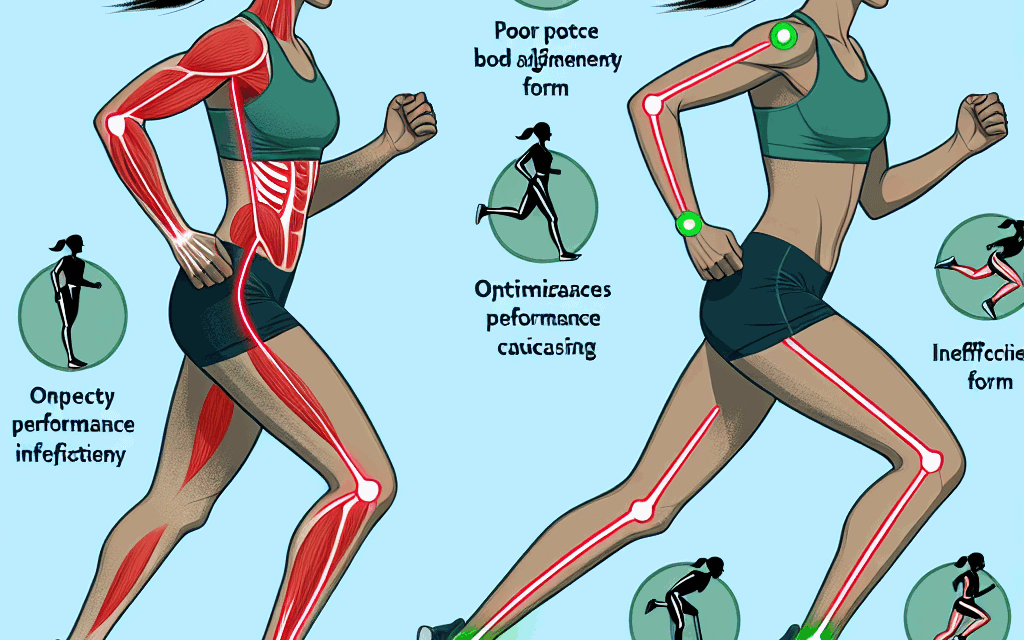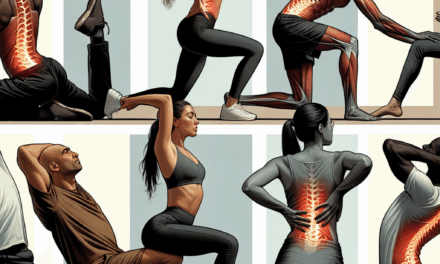Enhancing Sports Performance via Proper Body Alignment
In the world of sports, performance is often measured by speed, strength, agility, and endurance. However, one critical aspect that is frequently overlooked is body alignment. Proper body alignment can significantly enhance athletic performance, reduce the risk of injury, and improve overall physical health. This article delves into the importance of body alignment in sports, exploring its impact on performance, injury prevention, and recovery. We will also discuss techniques for achieving optimal alignment and the role of professional guidance in this process.
The Science of Body Alignment
Body alignment refers to the positioning of the body in relation to gravity and the ground. It encompasses the alignment of bones, joints, and muscles, which collectively influence movement efficiency and stability. Understanding the science behind body alignment is crucial for athletes aiming to enhance their performance.
When the body is properly aligned, it allows for optimal movement patterns. This means that the muscles can work more efficiently, reducing unnecessary strain and energy expenditure. Conversely, poor alignment can lead to compensatory movements, where other muscles take over the work of the primary muscles, leading to fatigue and potential injury.
- Biomechanics: The study of biomechanics reveals how forces interact with the body during movement. Proper alignment ensures that these forces are distributed evenly across joints and muscles, minimizing wear and tear.
- Posture: Good posture is a key component of body alignment. Athletes with proper posture can maintain balance and coordination, which are essential for peak performance.
- Muscle Activation: Proper alignment facilitates optimal muscle activation. When muscles are aligned correctly, they can contract more effectively, leading to improved strength and power output.
- Joint Health: Misalignment can lead to joint stress and degeneration over time. Proper alignment helps maintain joint integrity and function, which is vital for long-term athletic performance.
- Energy Efficiency: Athletes with proper body alignment expend less energy during movement, allowing them to perform longer and with greater intensity.
Research has shown that athletes who focus on body alignment can experience significant improvements in their performance metrics. For instance, a study published in the Journal of Sports Sciences found that runners who underwent alignment training improved their running economy by 5%, translating to faster race times.
Impact of Body Alignment on Athletic Performance
Body alignment plays a pivotal role in various aspects of athletic performance. From speed and agility to strength and endurance, the way an athlete’s body is aligned can make a substantial difference in their ability to perform.
One of the most significant impacts of body alignment is on an athlete’s speed. For instance, sprinters with optimal alignment can achieve greater stride lengths and frequencies, leading to faster times. A study conducted by the American College of Sports Medicine found that athletes with proper alignment could sprint 10% faster than those with misalignments.
- Speed: Proper alignment allows for more efficient force application during sprints, leading to improved acceleration and top speed.
- Agility: Athletes with good alignment can change direction more quickly and effectively, which is crucial in sports like soccer and basketball.
- Strength: Proper alignment ensures that the body can generate maximum force during lifts and explosive movements, enhancing overall strength.
- Endurance: Athletes with optimal alignment can maintain their performance for longer periods without succumbing to fatigue.
- Coordination: Good alignment contributes to better coordination, allowing athletes to execute complex movements with precision.
For example, a case study involving a professional soccer player revealed that after undergoing a body alignment assessment and subsequent training, the athlete improved their sprinting speed by 15% and reduced their risk of injury during the season. This highlights the tangible benefits of focusing on body alignment in sports.
Injury Prevention Through Proper Alignment
Injuries are an unfortunate reality in sports, often resulting from overuse, trauma, or improper mechanics. However, many injuries can be prevented through proper body alignment. When the body is aligned correctly, it can absorb impact and stress more effectively, reducing the likelihood of injury.
Common injuries associated with poor alignment include:
- ACL Tears: Misalignment in the knees can increase the risk of anterior cruciate ligament (ACL) injuries, particularly in sports that involve sudden stops and changes in direction.
- Shin Splints: Poor alignment in the lower legs can lead to shin splints, a common overuse injury among runners.
- Lower Back Pain: Misalignment in the pelvis and spine can contribute to chronic lower back pain, affecting athletes across all sports.
- Shoulder Injuries: Improper alignment in the upper body can lead to shoulder injuries, particularly in sports that require overhead movements.
- Plantar Fasciitis: Misalignment in the feet can lead to plantar fasciitis, a painful condition that affects runners and athletes who spend long hours on their feet.
Research indicates that athletes who engage in alignment-focused training programs experience fewer injuries. A study published in the British Journal of Sports Medicine found that athletes who participated in a body alignment program reduced their injury rates by 30% over a season compared to those who did not.
Incorporating exercises that promote proper alignment, such as yoga, Pilates, and strength training, can help athletes maintain optimal body mechanics. These practices not only enhance performance but also contribute to long-term health and well-being.
Techniques for Achieving Optimal Body Alignment
Achieving optimal body alignment requires a combination of awareness, practice, and sometimes professional guidance. Here are several techniques that athletes can use to improve their alignment:
- Postural Awareness: Athletes should develop an awareness of their posture during training and competition. Regularly checking in with body alignment can help identify areas that need improvement.
- Strength Training: Incorporating strength training exercises that target core stability and muscle balance can enhance alignment. Exercises like planks, squats, and lunges are effective for building strength in key muscle groups.
- Flexibility Training: Stretching and flexibility exercises can help maintain proper alignment by ensuring that muscles and joints have the necessary range of motion. Yoga and dynamic stretching are excellent options.
- Functional Movement Screening: Athletes can benefit from undergoing a functional movement screening to identify any imbalances or misalignments. This assessment can guide targeted training interventions.
- Professional Guidance: Working with a physical therapist, chiropractor, or sports coach can provide valuable insights into body alignment. These professionals can offer personalized assessments and corrective exercises.
For example, a professional basketball team implemented a body alignment program that included regular assessments and targeted exercises. As a result, the team saw a significant decrease in injuries and an increase in overall performance metrics, demonstrating the effectiveness of these techniques.
The Role of Professional Guidance in Body Alignment
While athletes can take many steps to improve their body alignment independently, professional guidance can be invaluable. Experts in sports medicine, physical therapy, and biomechanics can provide tailored assessments and interventions that address individual needs.
Professional guidance can include:
- Assessment: A thorough assessment of an athlete’s body alignment can identify specific areas of concern. This may involve analyzing movement patterns, posture, and muscle imbalances.
- Customized Training Programs: Based on the assessment, professionals can develop customized training programs that focus on correcting misalignments and enhancing performance.
- Injury Rehabilitation: For athletes recovering from injuries, professional guidance is essential for ensuring a safe and effective return to sport. Rehabilitation programs often include alignment-focused exercises.
- Education: Professionals can educate athletes about the importance of body alignment and how to maintain it during training and competition.
- Ongoing Support: Regular check-ins with a professional can help athletes stay on track with their alignment goals and make necessary adjustments to their training programs.
A case study involving a collegiate track and field team demonstrated the benefits of professional guidance. After working with a sports chiropractor, the team experienced a 40% reduction in injuries and improved performance across multiple events. This highlights the critical role that professional support can play in enhancing body alignment and overall athletic performance.
Conclusion
Proper body alignment is a fundamental aspect of enhancing sports performance. By understanding the science behind alignment, athletes can improve their speed, agility, strength, and endurance while reducing the risk of injury. Techniques such as postural awareness, strength training, flexibility exercises, and professional guidance can help athletes achieve optimal alignment.
The evidence is clear: athletes who prioritize body alignment not only perform better but also enjoy a healthier and more sustainable athletic career. As the sports community continues to recognize the importance of body mechanics, it is essential for athletes at all levels to incorporate alignment-focused practices into their training regimens.
In summary, enhancing sports performance through proper body alignment is not just a trend; it is a necessity for athletes seeking to reach their full potential. By investing time and effort into understanding and improving body alignment, athletes can unlock new levels of performance and longevity in their sports careers.





